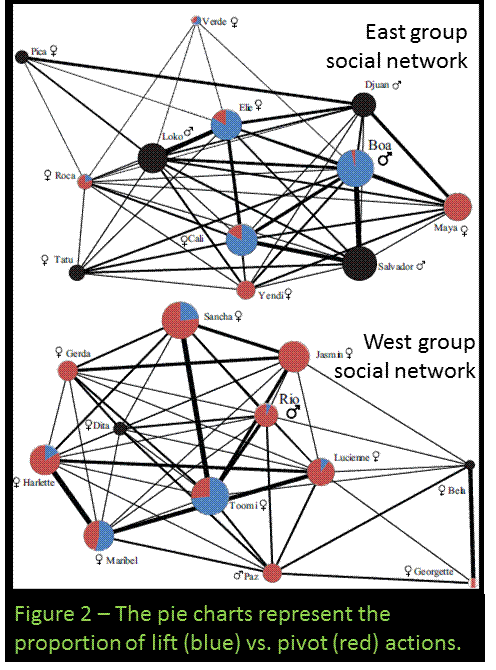Social networks shape monkey “culture”
A new study, published in Current Biology, shows that squirrel monkeys who are at the heart of their social group pick up innovations first, and are more likely to acquire new cultural variations in behaviour like novel foraging techniques.
Dr Nicolas Claidière, Ms Emily Messer and Professor Andrew Whiten of the University of St Andrews in collaboration with Dr Will Hoppitt of Anglia Ruskin University studied both our East and West squirrel monkeys. They examined their social networks by recording who spent time with whom when the monkeys were in the vicinity of an “artificial fruit” that could be used to obtain food rewards by using two different techniques, lift or pivot (Figure 1).
Sophisticated statistical analysis of this information revealed the details of the monkeys’ social networks which helped the researchers visualize which monkeys were at the heart of the network and which were more peripheral (Figure 2). Each monkey was rated on a measure of their ‘centrality’ within the group. 
Boa the alpha male in the East group was briefly separated and trained how to use the lift technique and his equivalent, Rio in the West group was trained to use the pivot technique, they were then reunited with their respective groups.
The scientists found that monkeys who were well-connected were the most likely to successfully pick up the new technique seeded in their group. They were also more likely to acquire the lift technique in the group seeded with ‘lift’, versus the pivot technique in the group seeded with ‘pivot’, so the alpha males were truly the hubs of these two different monkey ‘cultures’.
Professor Whiten, from the University of St Andrews, said: “Our study shows that innovations do not just spread randomly in primate groups, but as in humans, are shaped by the monkeys’ social networks”.
Dr Claidiere said: “Research interest in social learning and social network analysis has surged in recent years, and our results are likely to stimulate further research on the spread of innovations in animal social networks.
“We suspect that our focus on a social network relevant to the diffusion of foraging innovations can explain why we found an effect of the network centrality of individuals on their learning.
“Previous research has focused on other relationships, like who grooms whom, which may not correlate with the monkeys’ observational learning in the same way”.
Emily Messer, noted another aspect of the study. “We also found that maternal relationships explained parts of the social network, so some of the diffusion of the new foraging habits were also probably reflecting an emphasis on learning within families,” she said.
Click here to lead you to the abstract of the article in Current Biology

